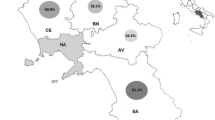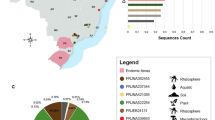Abstract
Knowledge of natural ecology is essential for a better understanding of pathogenicity and opportunism in black yeast-like fungi. Although etiological agents of diseases caused by these fungi are supposed to originate from the environment, their isolation from nature is difficult. This is probably due to their oligotrophic nature, low competitive ability, and, overall, insufficient data on their natural habitat. We obtained environmental samples from mangrove areas where mortalities by lethargic crab disease (LCD) are reported and areas without disease recorded. Isolation of chaetothyrialean black yeasts and relatives was performed using a highly selective protocol. Species-specific primers were used to determine if these isolates represented Exophiala cancerae or Fonsecaea brasiliensis, two proven agents of LCD, in order to test hypotheses about the origin of the disease. Isolates, identified by morphology as Fonsecaea- or Exophiala-like, were tested specific diagnostic markers for the fungi associated with LCD. Although several black fungi were isolated, the main causative agent of the LCD, E. cancerae, was not found. Molecular markers for F. brasiliensis revealed 10 positive bands for isolates from biofilms on mangrove leaves, branches, and aerial roots, of which four were confirmed by ITS sequencing. The absence of E. cancerae in environmental samples suggests that the species is dependent on the crab, as a genuine pathogen, different from F. brasiliensis, which is probably not dependent on the host species, U. cordatus. However, we did not attempt isolation from the marine water, which may represent the pathway of dispersion of the black yeast species between neighbor mangroves.


Similar content being viewed by others
References
Boeger WA, Pie MR, Ostrensky A, Patella L. Lethargic crab disease: multidisciplinary evidence supports a mycotic etiology. Mem Inst Oswaldo Cruz. 2005;100:161–7.
Boeger WA, Pie MR, Vicente VA, Ostrensky A, Hungria D, Castilho GG. Histopathology of the mangrove land crab Ucides cordatus (Ocypodidae) affected by lethargic crab disease. Dis Aquat Organ. 2007;78:73–81.
Orélis-Ribeiro R, Boeger WA, Vicente VA, Chammas M, Ostrensky A. Fulfilling Koch’s postulates confirms the mycotic origin of Lethargic Crab Disease. Antonie Van Leeuwenhoek. 2011;99:601–8.
de Hoog GS, Vicente VA, Najafzadeh MJ, Harrak JM, Badali H, Seyedmousavi S. Waterborne Exophiala species causing disease in cold-blooded animals. Persoonia. 2011;27:46–72.
Vicente VA, Orélis-Ribeiro R, Najafzadeh MJ, Sun J, Guerra RS, Miesch S, Ostrenky A, Meis JF, Klaassen CH, de Hoog GS, Boeger WA. Black yeast-like fungi associated with Lethargic Crab Disease (LCD) in the mangrove-land crab, Ucides cordatus (Ocypodidae). Vet Microbiol. 2012;158:109–22.
Ferreira CP, Pie MR, Esteva L, Mancera PFA, Boeger WA, Ostrensky A. Modelling the lethargic crab disease. J Biol Dyn. 2009;3:620–34.
de Hoog GS, Göttlich E, Platas G, Genilloud O, Leotta G, van Brummelen J. Evolution taxonomy and ecology of the genus Thelebolus in Antarctica. Stud Mycol. 2005;51:33–76.
Dixon DM, Shadomy HJ, Shadomy S. Dematiaceous fungal pathogens isolated from nature. Mycopathologia. 1980;70:153–61.
Prenafeta-Boldú FX, Summerbell RC, de Hoog GS. Fungi growing on aromatic hydrocarbons: biotechnology’s unexpected encounter with biohazard. FEMS Microbiol Rev. 2006;30:109–30.
Satow MM, Attili-Angelis D, de Hoog GS, Angelis DF, Vicente VA. Selective factors involved in oil flotation isolation of black yeasts from the environment. Stud Mycol. 2008;61:157–63.
Zhao J, Zeng J, de Hoog GS, Attili-Angelis D, Prenafeta-Boldú FX. Isolation of black yeasts by enrichment on atmospheres of monoaromatic hydrocarbons. Microb Ecol. 2010;60:149–56.
Sudhadham M, Dorrestein GM, Prakitsin S, Sivichai S, Chaiyarat R, Prakitsin S, Menken SBJ, de Hoog GS. The neurotropic black yeast Exophiala dermatitidis has a possible origin in the tropical rain forest. Stud Mycol. 2008;61:145–55.
Sterflinger K, de Hoog GS, Haase G. Phylogeny and ecology of meristematic ascomycetes. Stud Mycol. 1999;43:5–22.
Wang CJK, Zabel RA. Identification manual for fungi from utility poles in the Eastern United States. Lawrence: Allen Press; 1990.
Lutzoni F, Pagel M, Reeb V. Major fungal lineages are derived from lichen symbiotic ancestors. Nature. 2001;411:937–40.
Iwatsu T, Miyaji M, Okamoto S. Isolation of Phialophora verrucosa and Fonsecaea pedrosoi from nature in Japan. Mycopathologia. 1981;75:149–58.
Vicente VA, Attili-Angelis D, Pie MR, Queiros-Telles F, Cruz LM, Najafzadeh MJ, de Hoog GS, Pizzirani-Kleiner A. Environmental isolation of black yeast-like fungi involved in human infection. Stud Mycol. 2008;61:137–44.
Pie MR, Boeger W, Patella L, Vicente VA, Orélis-Ribeiro R, Ostrensky A. Specific primers for the detection of the black-yeast fungus associated with lethargic crab disease (LCD). Dis Aquat Organ. 2011;94:73–5.
De Hoog GS, Gerrits van den Ende AHG. Molecular diagnostics of clinical strains of filamentous basidiomycetes. Mycoses. 1998;41:183–9.
Fijan N. Systemic mycosis in channel catfish. Wildl Dis. 1969;5:109–10.
Richards RH, Holliman A, Helgason S. Exophiala salmonis infection in Atlantic salmon Salmo salar L. J Fish Dis. 1978;1:357–68.
Reuter RE, Hutchinson W, Ham J, Davis S. Exophiala sp. infection in captured King George whiting (Sillaginodes punctata). Bull Eur Assoc Fish Pathol. 2003;23:128–34.
Manharth A, Lemberger K, Mylniczenko N, Pinkerton M, Pessier AP, Kammeyer P, de Hoog GS. Disseminated phaeohyphomycosis due to Exophiala species in a Galapagos tortoise, Geochelone nigra. J Herpetol Med Surg. 2005;15:20–6.
Nyaoke A, Weber ES, Innis C, Stremme D, Dowd C, Hinckley L, Gorton T, Wickes B, Sutton D, de Hoog S, Frasca S Jr. Disseminated phaeohyphomycosis in weedy, Phyllopteryx taeniolatus, and leafy, Phycodurus eques, seadragons caused by species of Exophiala, including a novel species. J Vet Diagn Invest. 2009;21:69–79.
De Hoog GS. Evolution of black yeasts: possible adaptation to the human host. Antonie Van Leeuwenhoek. 1993;63:105–9.
Bonifaz A, Badali H, de Hoog GS, Padilla-Desgarennes C, Vázquez-González D, Navarrete G, Meis JF. Severe disseminated phaeohyphomycosis in an immunocompetent patient caused by Veronaea botryosa. Mycopathologia. 2013 (in press).
Li DM, Li RY, de Hoog GS, Wang YX, Wang DL. Exophiala asiatica, a new species from a fatal case in China. Med Mycol. 2009;47:101–9.
De Hoog GS. Significance of fungal evolution for the understanding of their pathogenicity illustrated with agents of phaeohyphomycosis. Mycoses. 1997;40 Suppl 2:5–8. doi:10.1111/j.1439-0507.1997.tb00555.x.
Li DM, de Hoog GS, Lindhardt Saunte DM, Gerrits van den Ende AHG, Chen XR. Coniosporium epidermidis sp. nov., a new species from human skin. Stud Mycol. 2008;61:131–6.
de Hoog GS, Nishikaku AS, Fernández Zeppenfeldt G, Padín-González C, Burger E, Badali H, Gerrits van den Ende AHG. Molecular analysis and pathogenicity of the Cladophialophora carrionii complex, with the description of a novel species. Stud Mycol. 2007;58:219–34.
Heinrichs G, Hübner I, Schmidt GK, de Hoog GS, Haase G. Compositional analysis of dark fungal biofilms from water taps using Tag Encoded FLX Amplicon Pyrosequencing. Mycopathologia. 2013 (in press).
Schmidt AJ. Estudo da dinâmica populacional do caranguejo-uçá, Ucides cordatus (Linnaeus, 1763) (Crustacea-Decapoda-Brachyura), e dos efeitos de uma mortalidade em massa desta espécie em manguezais do Sul da Bahia. Dissertation (in Portuguese). Universidade de São Paulo, Brazil. 2006.
Acknowledgments
Bert Gerrits van de Ende are thanked for technical assistance. The work of Vania A. Vicente was supported by Brazilian Government fellowship from Coordenação de Aperfeiçoamento de Pessoal de Nivel Superior (CAPES) and the work of Mohammad Javad Najafzadeh by Faculty of Medicine, Mashhad University of Medical Sciences, Mashhad, Iran. The authors also wish to thank the Brazilian agencies CAPES/Ministério da Educação—Brazil and Conselho Nacional de Desenvolvimento Científico e Tecnológico (CNPq) for financial support.
Author information
Authors and Affiliations
Corresponding authors
Rights and permissions
About this article
Cite this article
Guerra, R.S., do Nascimento, M.M.F., Miesch, S. et al. Black Yeast Biota in the Mangrove, in Search of the Origin of the Lethargic Crab Disease (LCD). Mycopathologia 175, 421–430 (2013). https://doi.org/10.1007/s11046-013-9636-1
Received:
Accepted:
Published:
Issue Date:
DOI: https://doi.org/10.1007/s11046-013-9636-1




